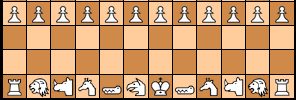[ List Latest Comments Only For Pages | Games | Rated Pages | Rated Games | Subjects of Discussion ]
Comments/Ratings for a Single Item
I think the Qalmaqini moves are explained as thus: Draw a line between the center of the Qalmaqini's square to the center of the opposing Padshah. The orthogonally or diagonally adjacent squares to the Qalmaqini that are in this path are which squares the Qalmaqini can move to. I do not think they promote since they can always potentially move.
I think this version is better than other Turkish Great Chess. Qalmaqini ,armed women, moves like a Shogi Pawn. Can Qalmaqini be promoted when reaching in the last rank?
The Qalmaqini sounds very much like the Shogi pawns. Am I right ?
That's the way it was: symmetrical with respect to a point rather than a line.
Setup for preset and diagram is asymmetric. Is that on purpose?
The Qalmaqini require a bit more explanation as to how they move exactly, I think.
If we call the armed female attendants Qalmaqini, and the bishop-knight a Bukhshi, then the king is called Shah instead of Padshah (emperor), and they are arranged Bukhshi, Wazir, Shah, Shahzadeh from left to right across each player's four central squares on the home-row. Murray says the version shown in the diagram above is the corrected version, but this other arrangement has its own internal logic. Probably there was some experimenting.
Besides its historical interest, this is a very interesting variant. The different central Pawns and the central Knights are intriguing. The selective use of the 3rd or forward rank bears consideration in designing other games too.
9 comments displayed
Permalink to the exact comments currently displayed.
